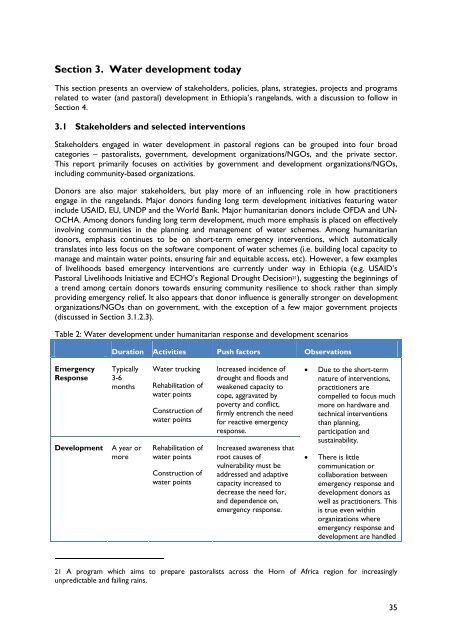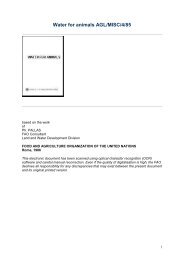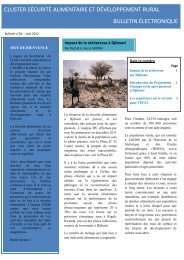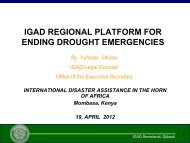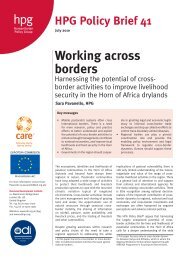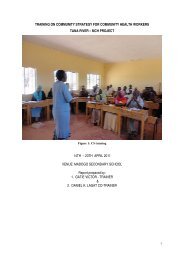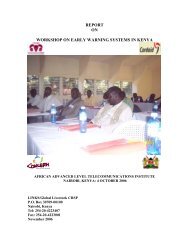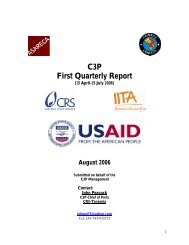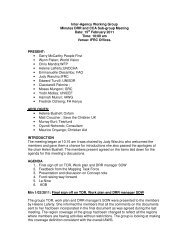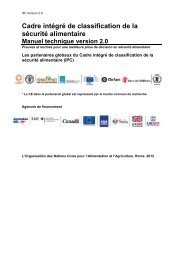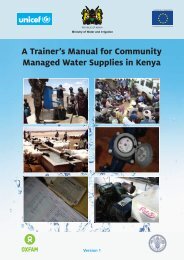Synthesis of Existing Knowledge and Experience on the Provision of ...
Synthesis of Existing Knowledge and Experience on the Provision of ...
Synthesis of Existing Knowledge and Experience on the Provision of ...
You also want an ePaper? Increase the reach of your titles
YUMPU automatically turns print PDFs into web optimized ePapers that Google loves.
Secti<strong>on</strong> 3. Water development todayThis secti<strong>on</strong> presents an overview <str<strong>on</strong>g>of</str<strong>on</strong>g> stakeholders, policies, plans, strategies, projects <str<strong>on</strong>g>and</str<strong>on</strong>g> programsrelated to water (<str<strong>on</strong>g>and</str<strong>on</strong>g> pastoral) development in Ethiopia’s rangel<str<strong>on</strong>g>and</str<strong>on</strong>g>s, with a discussi<strong>on</strong> to follow inSecti<strong>on</strong> 4.3.1 Stakeholders <str<strong>on</strong>g>and</str<strong>on</strong>g> selected interventi<strong>on</strong>sStakeholders engaged in water development in pastoral regi<strong>on</strong>s can be grouped into four broadcategories – pastoralists, government, development organizati<strong>on</strong>s/NGOs, <str<strong>on</strong>g>and</str<strong>on</strong>g> <strong>the</strong> private sector.This report primarily focuses <strong>on</strong> activities by government <str<strong>on</strong>g>and</str<strong>on</strong>g> development organizati<strong>on</strong>s/NGOs,including community-based organizati<strong>on</strong>s.D<strong>on</strong>ors are also major stakeholders, but play more <str<strong>on</strong>g>of</str<strong>on</strong>g> an influencing role in how practiti<strong>on</strong>ersengage in <strong>the</strong> rangel<str<strong>on</strong>g>and</str<strong>on</strong>g>s. Major d<strong>on</strong>ors funding l<strong>on</strong>g term development initiatives featuring waterinclude USAID, EU, UNDP <str<strong>on</strong>g>and</str<strong>on</strong>g> <strong>the</strong> World Bank. Major humanitarian d<strong>on</strong>ors include OFDA <str<strong>on</strong>g>and</str<strong>on</strong>g> UN-OCHA. Am<strong>on</strong>g d<strong>on</strong>ors funding l<strong>on</strong>g term development, much more emphasis is placed <strong>on</strong> effectivelyinvolving communities in <strong>the</strong> planning <str<strong>on</strong>g>and</str<strong>on</strong>g> management <str<strong>on</strong>g>of</str<strong>on</strong>g> water schemes. Am<strong>on</strong>g humanitari<str<strong>on</strong>g>and</str<strong>on</strong>g><strong>on</strong>ors, emphasis c<strong>on</strong>tinues to be <strong>on</strong> short-term emergency interventi<strong>on</strong>s, which automaticallytranslates into less focus <strong>on</strong> <strong>the</strong> s<str<strong>on</strong>g>of</str<strong>on</strong>g>tware comp<strong>on</strong>ent <str<strong>on</strong>g>of</str<strong>on</strong>g> water schemes (i.e. building local capacity tomanage <str<strong>on</strong>g>and</str<strong>on</strong>g> maintain water points, ensuring fair <str<strong>on</strong>g>and</str<strong>on</strong>g> equitable access, etc). However, a few examples<str<strong>on</strong>g>of</str<strong>on</strong>g> livelihoods based emergency interventi<strong>on</strong>s are currently under way in Ethiopia (e.g. USAID’sPastoral Livelihoods Initiative <str<strong>on</strong>g>and</str<strong>on</strong>g> ECHO’s Regi<strong>on</strong>al Drought Decisi<strong>on</strong> 21 ), suggesting <strong>the</strong> beginnings <str<strong>on</strong>g>of</str<strong>on</strong>g>a trend am<strong>on</strong>g certain d<strong>on</strong>ors towards ensuring community resilience to shock ra<strong>the</strong>r than simplyproviding emergency relief. It also appears that d<strong>on</strong>or influence is generally str<strong>on</strong>ger <strong>on</strong> developmentorganizati<strong>on</strong>s/NGOs than <strong>on</strong> government, with <strong>the</strong> excepti<strong>on</strong> <str<strong>on</strong>g>of</str<strong>on</strong>g> a few major government projects(discussed in Secti<strong>on</strong> 3.1.2.3).Table 2: Water development under humanitarian resp<strong>on</strong>se <str<strong>on</strong>g>and</str<strong>on</strong>g> development scenariosDurati<strong>on</strong> Activities Push factors Observati<strong>on</strong>sEmergencyResp<strong>on</strong>seDevelopmentTypically3-6m<strong>on</strong>thsA year ormoreWater truckingRehabilitati<strong>on</strong> <str<strong>on</strong>g>of</str<strong>on</strong>g>water pointsC<strong>on</strong>structi<strong>on</strong> <str<strong>on</strong>g>of</str<strong>on</strong>g>water pointsRehabilitati<strong>on</strong> <str<strong>on</strong>g>of</str<strong>on</strong>g>water pointsC<strong>on</strong>structi<strong>on</strong> <str<strong>on</strong>g>of</str<strong>on</strong>g>water pointsIncreased incidence <str<strong>on</strong>g>of</str<strong>on</strong>g>drought <str<strong>on</strong>g>and</str<strong>on</strong>g> floods <str<strong>on</strong>g>and</str<strong>on</strong>g>weakened capacity tocope, aggravated bypoverty <str<strong>on</strong>g>and</str<strong>on</strong>g> c<strong>on</strong>flict,firmly entrench <strong>the</strong> needfor reactive emergencyresp<strong>on</strong>se.Increased awareness thatroot causes <str<strong>on</strong>g>of</str<strong>on</strong>g>vulnerability must beaddressed <str<strong>on</strong>g>and</str<strong>on</strong>g> adaptivecapacity increased todecrease <strong>the</strong> need for,<str<strong>on</strong>g>and</str<strong>on</strong>g> dependence <strong>on</strong>,emergency resp<strong>on</strong>se.• Due to <strong>the</strong> short-termnature <str<strong>on</strong>g>of</str<strong>on</strong>g> interventi<strong>on</strong>s,practiti<strong>on</strong>ers arecompelled to focus muchmore <strong>on</strong> hardware <str<strong>on</strong>g>and</str<strong>on</strong>g>technical interventi<strong>on</strong>sthan planning,participati<strong>on</strong> <str<strong>on</strong>g>and</str<strong>on</strong>g>sustainability.• There is littlecommunicati<strong>on</strong> orcollaborati<strong>on</strong> betweenemergency resp<strong>on</strong>se <str<strong>on</strong>g>and</str<strong>on</strong>g>development d<strong>on</strong>ors aswell as practiti<strong>on</strong>ers. Thisis true even withinorganizati<strong>on</strong>s whereemergency resp<strong>on</strong>se <str<strong>on</strong>g>and</str<strong>on</strong>g>development are h<str<strong>on</strong>g>and</str<strong>on</strong>g>led21 A program which aims to prepare pastoralists across <strong>the</strong> Horn <str<strong>on</strong>g>of</str<strong>on</strong>g> Africa regi<strong>on</strong> for increasinglyunpredictable <str<strong>on</strong>g>and</str<strong>on</strong>g> failing rains.35


